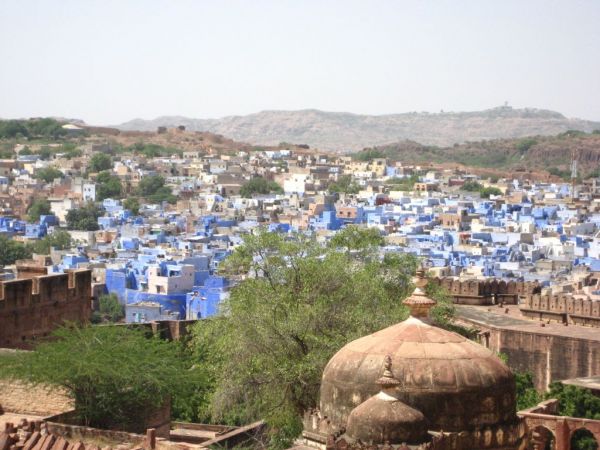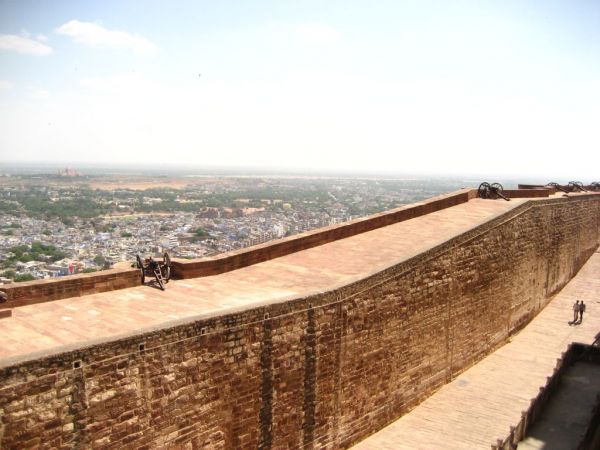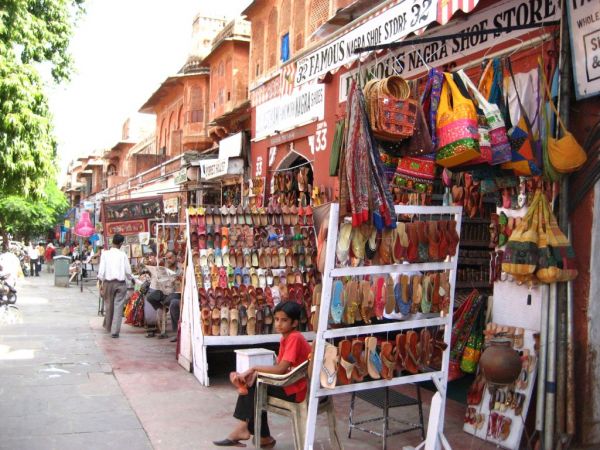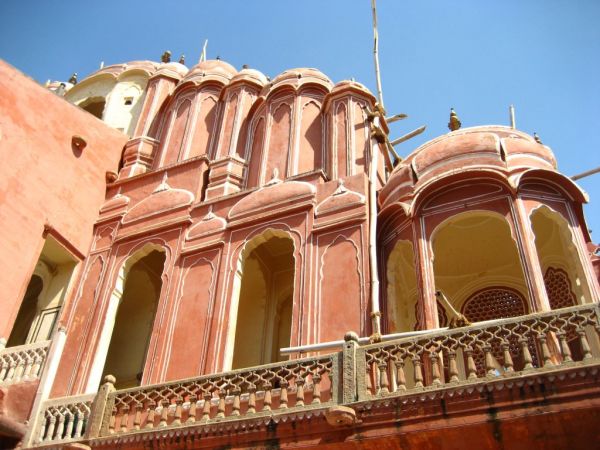The cow is holy in India and nobody is moved when one of them roams in the train station hall of Jaisalmer. We go to Jodhpur we reach late in the evening. We laid in a laid-back guesthouse among a maze of alleyways.
The close stitches of this asphalted network filter the sound pollution because only pedestrians and bicycles can slip through in some parts. Jodhpur is a quiet city. I didn't think we could use this term for an Indian town.
Jodhpur has the distinctive feature to be built around a fort overlooking the vicinity from the top of a mound, the Meherangarh fort which Kipling, in his day, described as "work of angels and giants". The winding and narrow streets lap its foothills. We pace them and step out a stairway leading to the fort.
So be the Rajasthan province; not a city that doesn't boast of possessing excessive fortifications within its close horizon.
We go though the fort entrance specially reinforced against the elephants' charges. The balconies, alcoves and main buildings got a particular attention from the local craftsmen. Outside, the inhospitable and gloomy lines of the ramparts to show the assailant he isn't very welcome and inside, the gentle bends of richly carved illuminations. Better to be from the maharaja side. Cannons occupy a few crenellations of the mighty wall and point at a hypothetical enemy. From the fortification, the vista on the blue city is splendid. Terraces on the rooftops, intricate alleyways and azure-hued walls. A soothing color which contrasts with the hostile desire of the cannons of the fortress.




















Before closing the short visit into the blue city we stop at the Jaswant Singh II memorial, benefactor of the town during the 19th century.



RTW-India
Wednesday 10 October 2007
The fortress of Jodhpur
By dorian on Wednesday 10 October 2007, 23:10
Tuesday 9 October 2007
On a dromedary's back in the Thar desert
By dorian on Tuesday 9 October 2007, 22:54
The stone castle dances in the desert wind of the Rajasthan. These thick bulwarks carry a bloody, more or less glorious past within their bowels. The fort of Jaisalmer knew its moments of prosperity, at the thriving time of the silk roads. Vendors of every kind sold their textiles, spices, elixirs and miraculous products. But the development of the maritime saling in the south of India suddenly shattered the opulent prosperity of the city nestled on the edge of the Thar desert. It had to wait for several centuries before some backpackers rediscover the serenity of this small hamlet overlooked by lofty ramparts. Sensing the fledgling market, a great deal of inhabitants turned towards this new type of modern business, the tourism. To the point to spoil the old buildings, from now on being weighed down with signs utterly dedicated to the tourists.
The touts fidget as soon as we get off the train and are omnipresent in the city. Up to lose patience several times. The inebriating alleyways within the ramparts are dotted with souvenirs shops and snake among sable-hued delicately chiseled buildings. Jaisalmer epitomizes Rajasthan where the time seems to get fixed. Most of tourists come here to enjoy riding a dromedary and sleeping on the sand dunes of the Thar desert.







We leave for a 3-day meharé in the desert. The jeep draws away the fort of Jaisalmer while a swarm of windmills whril in the glowing morning sky.

A short stop at the royal cenotaphs and we take our way again. We plunge into the flat and dry roads of the desert.




On the edge of the road, 2 heavily loaded dromedaries wait for their hosts. We make Badia's acquaintance who will guide us throughout this stroll in the desert.
We sit astride the animals and with a slow and gentle pace we leave to the unknown. The dromedary is not really comfortable. We often stop to get over our trials. We take advantage of the stops to watch this fascinating animal able of staying 2 weeks without drinking and then swallowing 200 liters of water within 3 minutes. The soles of their leg cushion the heavy carcass when the long bend neck swings at the rate of the steps. A timeless experience while we reach a bit of sand dunes where we get off the animal to spend the night. We run onto the sandy mounds. A magical sensation of the feet which sink into the blong sun-heat sand. We sit down on the crest of a dune, vague look and fixed mouth. These desert wind-shaped landscapes penetrate and mesmerize us. We share the diner in a deep silence and dash to settle a pile of blankets up a dune. Lying down on the sand area and the eyes skywards, the star-dotted sky shows our pettiness. Without being able to say anything, our looks peer into the sky, endeavour to piece the constellations together, capture the fleeting apparition of a shooting star or the slow trip of a satellite. We fall asleep as in a dream, a dream full of stars.








We sit astride our mounts for a long stroll, far from all. We start again our slow drift towards the inknown et lose the notion of time and space. Bushes and small trees immortalize the few signs of life that surround us and mark a set of dunes out. Without comparison with the Sahara infinity, the sunset over the dunes of the Thar desert remains poignant. The golden disc vanishes in the distance, the bronze shades darken and the first stars break through the celestial vault. A second magical night lying down on a dune, the hands crossed under the head and the eyes getting the light of these millions of stars and galaxies that slowly turn around the polar star. Silence and admiration.















Third and last day of our stroll and our dromedaries drop us off at the edge of the asphalted road where a jeep waits for us to go back to the fort of Jaisalmer.
A break in the desert utterly out of time and completely invigorating.
Thursday 4 October 2007
the pink city of Jaipur
By dorian on Thursday 4 October 2007, 14:58
The chaos reigns over the streets of Jaipur in which the deafening horns thunder most often without any reason. That's the law for the biggest one, derelict coaches impose themselves over the cars. The tuks-tuks force the way over the bicycles which have difficulty keeping a straight path. And among this turbulent blend of more or less up-to-date means of tranport, various animals roam about. Horses, cows or dromedaries tow merchandise-overflowing carts. Goats and pigs fumble around the garbage when some monkeys perform acrobatics onto the roofs. On the edge of the town, it's even possible to see a few elephants.
Welcome to the pink city of Jaipur.




We arrange a city tour with a tuk-tuk driver who offers us to dicover the different monuments of the town. 7 gates, 7 kilometers long and 7 bazaars sketch the old walled city. We go through one of the gates and realize all the buildings, walls and façades are pink. A colour that gives to the city an undeniable style. We stop at the Hawa Mahal, called the palace of the winds. A façade honeycombed with niches and balconies but unfortunately a set a bamboo scaffoldings square it off.




A stop at the city palace before enjoying the ingenious buildings of the astronomical observatory of Jantar Mantar. We look up to contemplate the largest sun clock in the world giving time with a 2-second precision.






We stop a few minutes in front of the Jal Mahal - the water palace. A superb castle which floats in the middle of a shimmering lake.


The funerary monument of Gaitor at the north of the town concludes this day rich with architectures and discoveries.
The next day, we go to visit the Amber castle and its bulwark, 11km away from the town. Above this first castle, the Jaigarh fort rises which, according to the legend would hold the lost treasure of the Kuchwahas. A fabulous treasure that disappeared when India got its independence. A few years ago, all the walls of the castle were scoured with metal detectors. In vain.
These castles come within the list of the superb medieval bulwarks which dot the Rajasthan, the most visited province in India. Like all the great sovereigns that made the History, the humanity keeps the remains of their megalomania. The thickness of the ramparts dissuades the bravest of the assailants and made the inhabitants of the kingdom feel safe. Today, the Amber fort is a museum and through the main gate we get in. The stone enclosure harbours some wonderful courtyards hemmed in by several austere rooms without any decoration. Only the royal bedroom is marvelously inlaid with thousands of diminutive mirrors.
With princely mind, we tread to visit the second fort. A ten-minute walk up in a overheating sun. From this fortification, we look at the first fort we visited a few minutes before and the edge of the city of Jaipur.
The day ends and it's time to walk down towards the rickshaw which drives us to our guesthouse after making a detour at the monkey temple. Second night in the pink city.












« previous entries - page 2 of 4 - next entries »





 visits
visits